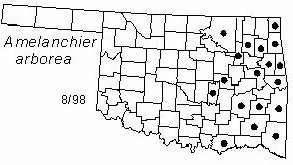Shrub or small tree to 10 m (35 ft) tall. Crown rounded. Bark gray to black. Twigs red-brown to black, hairy when young, becoming glabrous. Leaves alternate, simple, oval to oblong, 5-13 cm (2-5 in) long and 2.5-5 cm (1-2 in) wide; glabrous above, pubescent beneath; paler in color beneath; rounded or cordate at base, acute or acuminate at apex, margins finely serrate; petioles 3.8-5 cm (1.5-2 in) long, slender, pubescent when young, becoming glabrous with age. Flowers racemes, villose, numbering 6-12, 1.2-2.5 cm (0.5-1 in) long; calyx 5 cleft, campanulate; petals 5, white, long and strap-like; styles 2-5; stamens approximately 20; flowers appear from March to May. Fruits pomes, 0.6-1.2 cm (0.25-0.5 in), subglobose, on long pedicels, red-purple; numerous; fruits mature June to July.
Distribution: Newfoundland and Quebec, south to Florida, west to northeast Texas and Oklahoma, and north to Ontario. Common in eastern Oklahoma.
Habitat: forest understories on open hillsides and rocky slopes.
Comments: Amelanchier is derived from a French word for European species of serviceberry; arborea refers to the tree-like appearance. The fruits are rather tasteless, but mildly sweet.
There are many alternative common names for serviceberry, all of which refer to the appearance of its flowers. For example, shadblow refers to coincidence of flowering and the spawning of shad along the North Atlantic coast. In some eastern states, the flowers are gathered for church services, hence the name serviceberry or sarvis berry.
Economic uses: serviceberry is occasionally made into tool handles.
Wildlife benefits: serviceberries are eaten by numerous bird species, including mockingbirds, cardinals, cedar waxwings, towhees, Baltimore orioles, and many others. Rabbits and deer browse its stems.
NWI status: none
Distribution in Oklahoma: 
BACK
NEXT
RETURN TO INDEX
Last update: 9/8/99
 Go to Oklahoma Biological Survey Home Page
Go to Oklahoma Biological Survey Home Page
 Disclaimer
Disclaimer